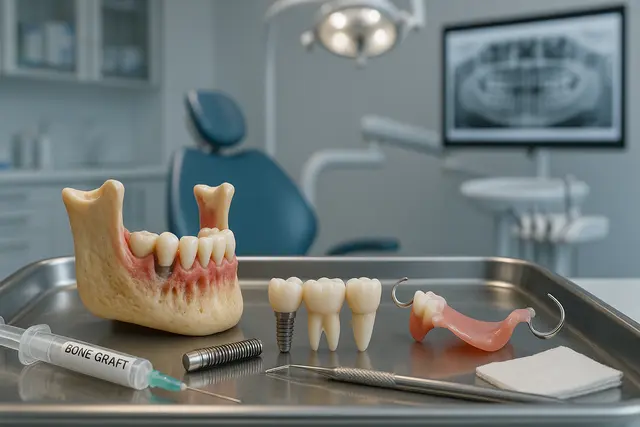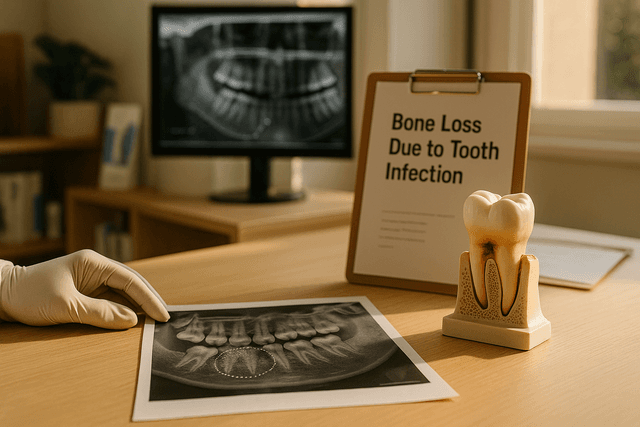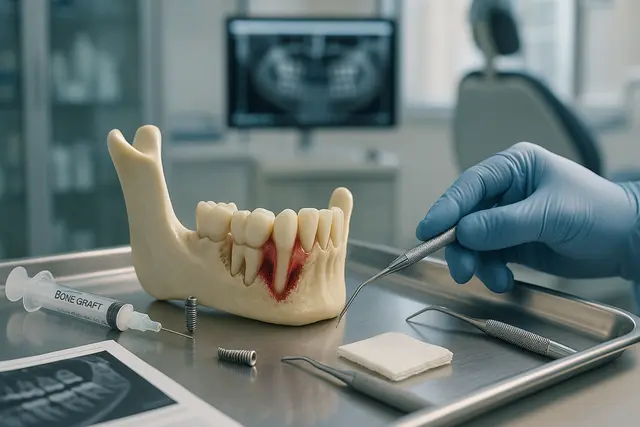Oral Health
6 min read
Jun 30, 2025
Chipped Tooth Repair at Home: Safe and Easy DIY Solutions
You bit down, heard a snap, and now your tooth has a jagged little secret. Whether it’s a small chip or a full-on break, the panic sets in fast, especially if the dentist’s office is closed.

So, you bit down on something crunchy, maybe that last popcorn kernel or an enthusiastic chunk of peanut brittle, and snap. Your tooth didn’t sign up for that job. Now there’s a small chip (or a not-so-small one), and you’re suddenly hyper-aware of every breath, sip, or bite.
We get it. A chipped or broken tooth can make your whole mouth feel off, and while seeing a dentist is always the safest route, sometimes you need a quick fix now. Whether it’s late at night, the weekend, or you’re waiting for an appointment, we’ve got you covered with safe and smart ways to handle chipped tooth repair at home.
Let’s break it all down, minus the scary dentist chair.
What To Know Before You Try Any Dental Fix at Home
First, a reality check. While we’re about to talk you through smart home strategies, you should always plan to see a dentist. Even a small chip in your tooth can open the door to tooth decay, gum irritation, or infection down the road.
So consider everything below as a temporary fix, not a forever solution. That said, if you’re dealing with sensitive teeth, a jagged edge, or that unmistakable throb of tooth pain, a little DIY dental repair can go a long way in easing discomfort and protecting the affected tooth.
How to Fix a Chipped Tooth at Home (Without Making It Worse)
Let’s start with a super common question: Can you fix a chipped tooth at home?
Yes, sort of. You can make it look better, feel better, and even avoid more tooth damage, but you’re not rebuilding the full structure of a front tooth or filling a cavity on your own. Still, you can smooth out a rough surface of the tooth, protect the tooth, and buy yourself time until that dental visit.
Here are your best bets for caring for a chipped tooth at home:
Rinse your mouth gently with warm salt water to keep it clean and reduce swelling.
If there’s pain or swelling, apply a cold compress and use a safe pain reliever like ibuprofen.
Avoid cold foods and very hot drinks, they can fire up sensitive teeth real quick.
Stick to soft foods and chew on the opposite side of your affected tooth.
Using a Tooth Repair Kit for a Quick, Painless Fix
Now for the fun part: playing amateur dentist with a tooth repair kit. You’ll find over-the-counter options that include temporary tooth filling materials, applicators, and sometimes tooth-colored composite resin to help disguise the chip or break.
A good tooth repair kit for filling works best on small cracked teeth, chipped edges, or loose cap and lost filling situations. You can also find specialized products like:
Cap and lost filling repair materials for when part of a dental filling falls out.
Denture repair kits for folks dealing with damaged teeth in partials or full sets.
Temporary tooth replacement kits that use moldable false teeth or false teeth beads to rebuild a missing tooth until your appointment.
Pro tip: Always follow instructions to a T, and don’t try to reshape or grind any material once it sets. That’s a fast track to a second chip, or worse.
How Veneers and Resin Materials Factor Into DIY Fixes
You’ve probably heard of veneers, especially if you’ve ever envied a celebrity’s perfect smile. While actual porcelain and resin crowns are only installed by a dentist, some diy tooth kits include plastic versions meant to temporarily cover chipped teeth or gaps. They’re not permanent teeth (and you shouldn’t pretend they are), but they can help if you’ve got a chipped tooth at home and need to look presentable for a wedding or Zoom meeting.
For cosmetic masking or rebuilding part of the tooth, composite resin can help, though keep in mind, a dentist can use a filling far more effectively than we can.
When You Have a Chipped or Broken Tooth on the Front Line
Let’s say you’ve chipped a front tooth, aka the most visible spot in your smile. Cue the panic. It’s not just about tooth repair anymore; now it’s personal.
If your tooth breaks or chips and leaves a small crack or chip, here’s what you can do:
Cover any sharp edges with dental wax, wax paraffin or sugarless chewing gum to avoid cutting your gum line or inner cheek.
Use a temporary tooth cap to fill the space for a better look and feel.
Avoid biting into anything firm until you can get it checked.
Whether you're repairing a chipped incisor or covering a chipped or broken tooth with a tooth filler, always check that the materials are oral-safe and labeled for short-term use.
Temporary Tooth Repair: How Long Is It Safe?
We’ve all pushed things a little too far, but let’s not do that with your tooth enamel. While temporary tooth filling materials and temporary tooth replacement kits can offer relief, they should never be used as long-term substitutes for professional dental care.
At most, consider these solutions to buy you a few days or weeks. Beyond that, bacteria can creep in under DIY repairs and lead to a root canal, a full dental repair, or even worse, a missing tooth situation.
Dental Care for Chipped and Broken Teeth: What NOT to Do
Here’s the part we wish more people knew:
Don’t use glue. Ever. Not even if it says “non-toxic.”
Don’t bite your nails, chew ice, or grind your teeth (a common cause of tooth damage and broken teeth).
Don’t eat sticky candy or tough meats with the remaining tooth. One wrong move and you could chip your tooth again, or fix a broken tooth the hard way.
What Happens If You Ignore It?
Sure, the chip might feel small, but cavities, and cracked or broken spots don’t get better on their own. Without dental attention, the damage can spread, irritate the gum, and affect neighboring permanent teeth.
If you’ve tried filling the missing broken tooth with a kit for filling the missing gap and things still feel off, it’s time to see a dentist. Honestly, it’s time to visit your dentist even if things feel “fine.” Better safe than sorry, or toothless.
Real Ways to Fix a Chipped Tooth (With or Without a Dentist)
Let’s recap with a quick cheat sheet of ways to fix a chipped or chipped and broken tooth:
Smooth it: Use dental wax to cover any sharp jagged edge or corner.
Protect it: Use a tooth repair kit or temporary tooth filling until your dental appointment.
Replace it: If you’re missing a chunk or whole tooth, try moldable false teeth or false teeth beads for a fast fix.
Clean it: Gently rinse your mouth with warm salt water and skip foods that trigger sensitive teeth.
Cover it: Cosmetic options like tooth-colored composite resin or a DIY veneer might save your next photo op, but only for a bit.
A Friendly Reminder From Your Future Smile
Look, you don’t have to live with a cracked tooth, an awkward smile, or the constant nagging fear that your next bite might be the last straw for your tooth enamel. Home solutions can help you feel better right now, but dental repair is always the finish line.
So yes, it’s totally okay to handle your broken tooth at home today. But promise us one thing: when Monday rolls around, see your dentist. You, and your smile, deserve the real fix.
Can You Fix a Chipped Tooth at Home Safely?
Yes, but only temporarily. You can rinse with warm salt water, apply dental wax to cover sharp edges, and use an over-the-counter tooth repair kit to reduce sensitivity and discomfort. These home solutions protect the tooth short-term but aren’t substitutes for professional dental care.
What Is a Tooth Repair Kit and How Does It Work?
A tooth repair kit includes temporary filling materials that cover chips, cracks, or lost fillings. You clean and dry the area, then apply the putty-like material as directed. It creates a short-term barrier to ease pain and prevent further damage, but it’s only meant to last a few days.
How Do You Treat a Chipped Front Tooth at Home?
For a chipped front tooth, cover any jagged edges with dental wax or sugarless gum. Avoid biting directly into foods and use a temporary tooth cap or cosmetic resin for appearance if needed. These steps help prevent irritation and keep your smile presentable until you can see a dentist.
Why Shouldn’t You Ignore a Chipped or Broken Tooth?
Even a small chip can lead to decay, infection, or further breakage if left untreated. DIY fixes wear down, and bacteria can slip in through cracks. Seeing a dentist ensures the tooth is properly repaired and protected for the long term, reducing your risk of more serious dental problems.
Read Next
Related Posts

Oral Health
Tooth Replacement Options to Prevent Bone Loss
Losing a tooth isn’t just about appearance, it can have a lasting impact on your oral health, jawbone strength, and overall quality of life. When teeth go missing, the jawbone begins to shrink, which can change your bite, your facial structure, and even your confidence. Fortunately, modern dentistry offers several effective solutions to replace missing teeth and prevent further bone loss.
4 min read
Sep 26, 2025

Oral Health
Bone Loss Due to Tooth Infection Explained: What It Means for Your Oral Health
A tooth infection isn’t just about pain, it can quietly damage the tissues around a tooth and even erode the jawbone that supports your smile. This guide explains how infections start, why they can lead to bone loss, the warning signs to watch for, and the treatments that can stop the spread and rebuild lost support.
5 min read
Sep 25, 2025

Oral Health
Understanding Bone Loss in Teeth: Causes and Treatments That Work
Bone loss in teeth is a silent threat that can compromise your smile, facial structure, and overall oral health. While it often goes unnoticed in the early stages, it can lead to serious consequences if left untreated. Understanding what causes dental bone loss, and how to prevent or manage it, is key to maintaining a strong, healthy foundation for your teeth.
5 min read
Sep 25, 2025
Don’t have time to research every dentist around you?
See why 30k+ patients trusted us